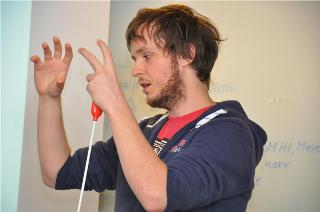Feb 23 2015
Regional climate change models predict an increased freshwater runoff into the Baltic Sea. This will result in increased inflow of terrestrial dissolved organic carbon.
 Matyas Ripszam. Photo by Kristina Viklund
Matyas Ripszam. Photo by Kristina Viklund
According to Matyas Ripszam, Umeå University, this change will have high impact on the organic pollutants on the organic pollutants in the northern Baltic Sea, since this carbon can interact with the pollutants and decrease their concentration in the water. He defends his thesis on Friday 20 February.
“This doesn’t mean that the organic pollutants become less of a threat. A higher organic carbon load might lead to the development of ecosystems where microorganisms mainly feed on dissolved organic carbon, thus opening a way for the pollutants to enter the food web and cause more problems in higher level organisms, like fish”, says Matyas Ripszam.
The ability to sorb organic pollutants has shown to differ between different parts of the Baltic Sea. Matyas Ripszam has successfully developed a method to measure the extent to which contaminants partition to dissolved organic carbon.
This method was then applied to samples taken along the full length of the Baltic Sea coast. Most of the pollutants studied showed decreasing affinities from north to south. Some contaminants with specific structural properties showed no spatial differences in partitioning to dissolved organic carbon.
Matyas Ripszam has also examined the effects of higher temperature and different concentration of organic carbon content on the distribution of pollutants in modelled real-life marine ecosystems, so called mesocosms. Higher temperature alone led to increased losses of pollutants, whereas higher organic carbon content retained more pollutants in the model ecosystems.
“The combined effect of both parameters showed no real patterns, as some pollutants were more sensitive to changes in temperature and others to increased organic carbon content”, says Matyas Ripszam.
The research has been carried out within the research programme Ecochange. The mesocosm experiments were carried out at Umeå Marine Sciences Centre.